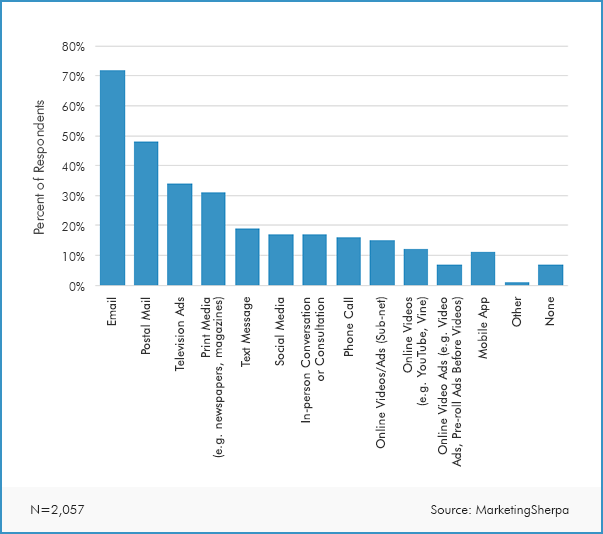Every good brand needs to have an online presence. Brands with well-designed websites are considered far more credible than those without.
Populating your website with useful content that uses the right keywords allows you to appear on search engines, but what comes next? After optimizing your website content for SEO, it’s time to create campaigns that can reach customers wherever they are.
When it comes to connecting with customers online, nothing’s better than adding email marketing into the mix. 72% of US adults prefer companies to communicate with them through email, and it remains the most popular choice across age demographics. It even holds its own against traditional media which usually outperforms other digital channels.

Source: MarketingSherpa
Formulating a good email campaign, or improving on your current one doesn’t need to be complicated. You just need to keep these four tips in mind:
1. Segment your email lists.
To avoid being marked as spam, make the first step toward email personalization with list segmentation.
Personalization can deliver a 5 to 15% increase in revenue and a 10 to 30% increase in marketing spend efficiency.
Segmentation refers to the practice of separating subscribers within email lists according to key audience demographics. This way, subscribers receive a more tailored email marketing experience, in contrast to a generic email blast with singular messaging. Some common segments you can use are:
- Age range
- Gender
- Occupation
- Location
- Interests
- Email engagement
- Purchase history
- Website behavior
Segmenting email lists and tailoring your messages according to user behavior or their purchase history increases the likelihood that your subscribers will open your emails. Subscribers will likely click the CTA in the email and make a purchase if the offers are relevant to them, thereby increasing your click-to-open rates. When you improve email engagement, chances are you drive your email marketing revenue as well.
Here’s a good example of behavior-based list segmentation: Say you’re the CMO of an ecommerce fashion store. You can tell your email marketing team to segment subscribers by reviewing their purchase histories to see what type of products they’re usually interested in. Your email marketing team can then include offers for similar products in your promotional emails.
2. Show your subscribers what they expect to see.
There are some brands that make the mistake of promising something grand in the subject line of an email and not fulfilling this promise in the body of the email.
This is a bad email marketing habit that can do significant harm to your revenue targets. It can lead to subscribers getting annoyed and unsubscribing from your list.
The truth is, writing a punchy, clickbaity subject line can improve your open rates. But if your goal is to drive revenue, your email should be optimized so that subscribers are encouraged to click on the CTA within the email.
Don’t make promises you can’t keep. Instead of relying just on attractive “email power words,” maximize your use of these words by taking note of these tips:
- When using email marketing software, use personalization tags to address subscribers by name. Include your subscriber’s first name in the subject line, and greet them in the body of the email (Hi there, James!)
- Craft email lines based on location, purchase history, or even occasion—hence why proper segmentation is integral.
- Build rapport with the right pronouns. Use “you” and its variants to underscore the personal communication aspect of your emails.
- Play on urgency and excitement, but be honest about it. This works especially well when combined with power words like “special,” “new,” “storewide sale,” “event,” and “offer.”
The more you align your subject lines with the content you offer in the body of your email, the more likely your subscribers will make a purchase.
3. Engaging content makes a world of difference.
The main purpose of email marketing is to promote your business’ products or services. The two email marketing metrics that indicate how successful your promotion are click-through rate and click-to-open rate.
According to email marketing benchmarks for 2019, the average click-through rate is 2.69%. Meanwhile, the average click-to-open rate is 14.10%. Developing genuine connections with your subscribers is an excellent way to improve these engagement metrics. Think about what types of content will make your subscribers trust your brand?

- Authentic content. Be clear about what your company’s vision and goals are. Reflect this in your branding.
- Transparent content. Let your customers know where their money is going and how you plan to use their information—especially in this data-sensitive time.
- Consistent content. Have a set of guidelines for your brand presentation and tone. Being consistent in all aspects of your email messaging makes it easier for subscribers to recall your brand.
Here’s how to ensure that your emails are consistent.
- Images and Layout – Use colors and imagery that showcase your company’s branding standards. Include your logo within the layout in a visible but unobtrusive area. For photos, use lifestyle shots that showcase real people using your products and services as much as possible.
- Copy – Don’t be condescending. Keep text readable, whether someone views your email on mobile or desktop. Organize information hierarchically, with important information kept at the top in a larger size, and explain in more detail afterward.
4. Test everything
It’s difficult to get everything right the first time. However, with A/B testing you can learn what works and take your ROI to the next level.
A/B testing can improve ROI because it enables you to identify what works best for each specific situation.
Sending two different variations of the same email with slight changes can give you concrete data on which elements get desired results and which ones don’t.
The great thing about A/B testing is that you can do it for every element of your emails such as the subject line, layout, CTAs, copy, and more.
A/B testing is extremely important for optimizing your CTAs since they direct subscribers to take action and convert. Here are some tips on how you can optimize your CTA designs:
- Use a button. Everyone instinctively knows buttons are where you click. Deviating from this will only cause confusion.
- Use the right colors—but test multiple ones. Pick one that doesn’t clash with the color of the text within it.
- Think about where to place them. You can put it above the fold, on the right-hand side, at the bottom, or more.
- Don’t crowd them. They need to be visible.
Key Takeaways
Building the perfect email marketing campaign can be exhausting work, especially if you seek to perfect every detail. However, as each element in a well-designed email works together to attract more subscribers to click, improving one part can make a difference to the whole.
There are many ways to improve email marketing ROI. Segmenting your email lists can decrease your spam rate, improve open rates, and lower bounce rates. Tweaking your subject lines can improve both open and click-through rates. Putting more thought into organizing your content can massively impact click-through and click-to-open rate. And A/B testing may be the thread that ties it all together.
Benchmarks are there to assess marketing performance. They’re an opportunity to improve your relationship with email subscribers. Don’t take this for granted: after all, they could be your next customers.



